 |
Senimen |
last update:
27.07.2011
|
Historical Data
| Name |
Title |
|
Origin |
Tomb |
Senimen
cn.j
mn |
Steward and Nurse of "God's Wife of Amun" Neferu-Ra |
|
|
TT252 (P&M I-1, 337; at Sheikh Abd el-Qurna) |
| Wife: |
|
|
|
|
| Parents |
|
|
|
|
| Father: |
|
|
|
|
| Mother: Seniemyah |
Lady of the House |
|
|
|
| Brother(s): |
|
|
|
|
| none known |
|
|
|
|
| Sister(s): |
|
|
|
|
| none known |
|
|
|
|
For a long time Senimen was regarded to be the fourth brother of Senenmut
(e.g. Meyer, 1982) and his successor in both, the office of the tutor (=
"Nurse") of Neferu-Ra and the "custodian of the God's wife, Neferu-Ra".
This assumption, that he has been a brother of Senenmut is probably based on a representation in
the monument of Senenmut, TT71.
In the axial corridor of TT71 a relief on the southern wall (today,
this scene is visible only on a photo taken by the expedition of the Metropolitan
Museum of Art, New York; inside the tomb, today the scene(s) are completely
destroyed) showed a list of offerings (as a part of a funeral banquet of
the deceased). On the western part of that list, Senenmut was depicted looking eastwards, on the other
side, Senimen was portrayed together with a wife called "Seniemyah", both
looking westwards (in addition, see the reconstruction of the wall on page
"TT71 - Rock cut Stelae of Senenmut"; after Dorman, 1988).
|
The relationship with Senenmut was stated 1906 by Sethe,
who published a few manually copied lines of the accompanying text above Senimen and Seniemyah:
- his (beloved) brother,
- hereditary prince, count, seal-bearer of the king of lower Egypt,
- steward, great tutor
- of the king´s daughter, Senimen,
- justified before the large God. His [beloved wife],
- beloved of him, Seniemyah, justified.
|
|
Roehrig and Dorman (1987) reexamined the badly destroyed
southern wall again, and got convinced that Sethe falsely assigned the
inscription in several columns to the persons illustrated below the text.
Thereafter, the inscription containing the phrase "his (be loved)
brother" does not refer to Senimen (who is portrayed far away from this text), but to
the ritual conducted by a priest who was portrayed directly below.
|
|
A familiar connection between Senenmut and Senimen as stated by Sethe - based on the
inscriptions he had copied in TT71 - could not be proven anywhere else, neither in
the 2nd monument of Senenmut, TT353 (where all his brothers and sisters had
been portrayed), nor in Senimen's own monuments.
|
|
Beyond that Roehrig and Dorman point out that the vulture-sign
for "mwt"
had been thoroughly chiseled away were ever it has occurred in
TT71, because this
sign is constituent of the name Senenmut. They are convinced that
during this action also the word "mut = mother" before the name of Seniemyah
was destroyed - it can be "easily" restored at the appropriate
places without big problems.
|
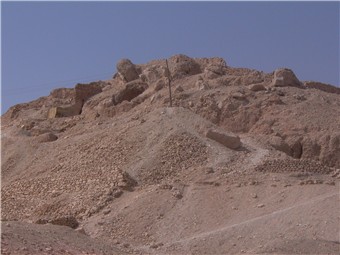
| The photo above shows the hill-side of "Sheikh Abd el-Qurna"
with the tomb TT252. The
tomb of Senimen is located on the same hill right from and somewhat below
the monument of Senenmut, TT71. From below the tomb is hardly to discover,
however, on the right side of the mast there is the group of statues
of Senimen to be seen (s. below),
TT252 is directly below the group. |
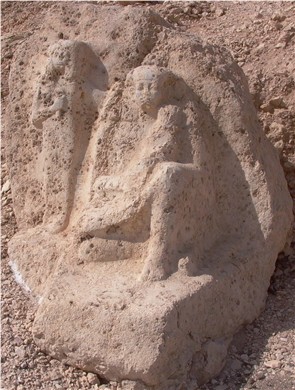
|
Like Senenmut, Senimen has placed above his tomb a group of statues, which show him together with Neferu-Ra on the
lap - according to his title "Nurse of the God's wife" the
princess is shown in a "nursing position". In
addition, the group shows a woman standing on his right side. Norman de
Garis Davies who examined the group together with Gardiner reconstructed the
much weathered text as follows "His wife Sen[iemyah], justified, born of
the house-mistress, Tu-ef, justified" (Davies, N d. Garis, PSBA 35, 1913).
However, referring again to the much weathered inscription Davies finally raised
the option that Tu-ef may have been the wife of Senimen. |
| Roehrig (see: Roehrig, C. H., The Eighteenth Dynasty titles royal nurse (mn't nswt), royal tutor (mn'
nswt), and foster brother/sister of the Lord of the Two Lands (sn/snt
mn'n nb tAwy). 1990, p. 59, footnote 169) rejected the
reconstruction of Davies and assumed that "Tu-ef" was the wife of Senimen. |
|
In the tomb of Senenmut, TT71, three linen fragments had been found, which were
signed for Senimen. The so-called fragment A contains inscriptions in 16 columns, among them the name of Seniemyah
is mentioned in the following
context:
"… Senimen, ms.n (= born by)
nb[t pr ] (= the lady of the house) Seniemyah
..." |
|
Since we know that Hat-nefret (@At-nfrt)
is the mother of Senenmut and nothing is known about a second wife of
his father
Ra-mose (Ra-ms), it is very unlikely
that Senenmut and Senimen are related to each other.
|
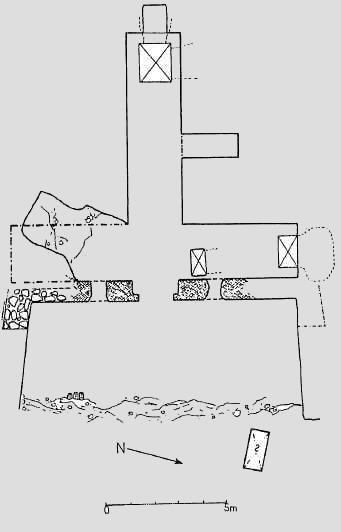
| Above modified floor plan of tomb TT252 according to Kampp (1996),
below condition of the facade today. |

|
Like the first monument of Senenmut, TT71, the tomb of Senimen was cut T-shaped into the rock,
it has a small forecourt and a front with one window each right and left
from the entrance (see above).
|
| Above the T-shaped tomb Kampp (1996) reconstructed three
chapels made of mud-brick and lime-stone. The left chapel contained the group of
statues with Neferu-Ra (see photo above) which was cut directly out of the rock.
The content of the two other chapels as well as the appearance of the chapels
which most likely had been plastered can not be reconstructed anymore. |
| The floor of the T-shaped tomb is about 50 cm below the
courtyard in front of the tomb. Since the condition of the tomb which had been
cut out of sedimentary rock is very bad it cannot be concluded whether the tomb
ever had been finished - although there are remains of a painted decoration on
the white plaster attached to ceiling (see photo below). |
| Several burial shafts had been cut in front and inside the
tomb. The shaft a the end of the right wing of the transverse hall as well as
the one at the end of the axial corridor might have been part of the original
plan. The burial shaft directly right behind the entrance to the transverse hall
and the tunnel in the middle of the axial corridor belong most likely to a later
reuse of the tomb. |
| Outer and inner parts of the tomb are largely destroyed. The two
pictures below show the left and the right wings of the floor. The left picture shows on its
right side - opposite to the entrance to the tomb - the opening of the axial corridor, the right picture shows a
shaft at its end.
|
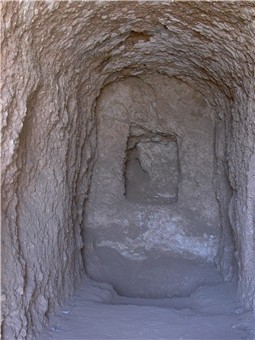
|
The axial corridor ends up with a small niche in which most likely a
statue or a stela had been mounted. The tomb was at least partly decorated,
however, only a very small part of the decoration has survived on the
ceiling (see photo below).
|
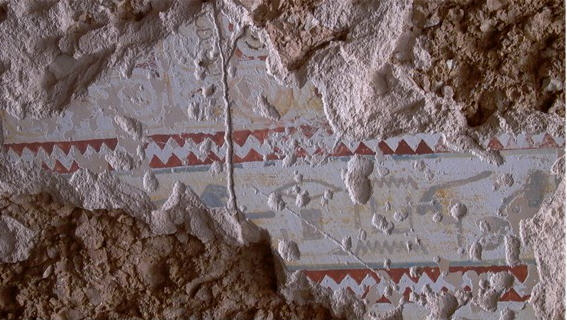
|
Inside the tomb of Senimen, TT252, several fragments had been found, e.g.
lintel and jambs from a door, canopic jars of the deceased, and fragments of a relief
containing a cartouche of Hatshepsut.
|
| From his tomb TT252 the following funerary cone has survived: |
|
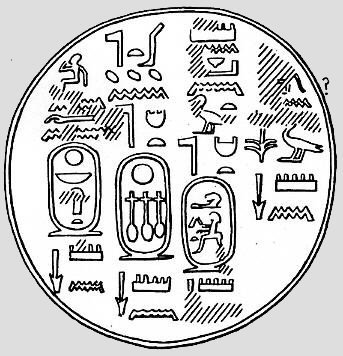 |
|
Inscription (Zenihiro, 2009):
Xrd n kAp n nb-pHtj-ra sn-mn
pdsw nTrt n Hmt-nTr nfrw-ra sn-mn
mnaj n sAt Hmt-nTr HAt-Spst sn-mn
jmj-rA pr n sAt-nswt sn-mn
Child of the kap of Ahmose Senimen,
flesh of goddess of god's wife Neferu-Ra Senimen,
tutor of daughter of god's wife Hatshepsut Senimen,
steward of king's daughter Senimen.
According to Gitton, 1984, S. 72, footnote 133, the title "pdsw nTrt n Hmt-nTr nfrw-ra"
is still mysterious.
|
Funerary cone of Senimen from TT252; Macadam Nr. 120;
Ř ? cm |
|
|
The inscription on the funerary cone allows a rough estimation
of the lifetime of Senimens:
- he states that he has been a "Child of the kap of [king] Ahmose", and
furthermore as "Flesh of the goddess of god's wife Neferu-Ra";
-
if one accepts that Neferu-Ra became "God's wife of Amun" not before
Hatshepsut's accession to the throne, i.e. at the latest in year 7,
-
then Senimen was born sometime during the reign of Ahmose, outlived the kings Amenhotep I,
Thutmosis I and II, and died during or after year 7 of Hatshepsut.At least
the reigns Amenhotep I, Thutmosis I and II add up to about 46 years (data
according to: Hornung, Krauss, Warburton, 2006; possible coregencies not taken
into account), adding another 7 years until the accession to the throne of
Hatshepsut, then Senimen died at an age of 53 years or more (depending how long
he already lived during the reign of Ahmose). |
|








